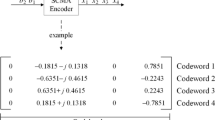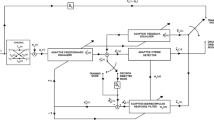Abstract
A systolic array implementation of the one-shot decorrelating detector algorithm designed for Code-Division Multiple-Access (CDMA) spread spectrum communication systems used in mobile communications environments is developed. This detector has the advantage that it is near-far resistant, that is, it minimizes the interference effects that near-end users have on far-end users. However, its implementation requires the on-line inversion of the correlation matrix between the desired and interfering users. For this reason, a systolic computation approach is chosen to help solve the problem of fast on-the-fly matrix inversion. Performance of the proposed implementation is assessed via digital computer simulation. The implementation methodology presented here leads to a VLSI implementation structure.
Similar content being viewed by others
References
R. Lupas, “Near Far Resistant Linear Multi-User Detection”, Ph.D. Dissertation, Princeton University, January 1989.
R.L. Pickholtz, L.B. Milstein and D.L. Schilling, “Spread Spectrum for Mobile Communications”, IEEE Trans. Veh. Technol., Vol. 40, No. 2, pp. 313–321, 1991.
W.C.Y. Lee, “Overview of Cellular CDMA”, IEEE Trans. Veh. Technol., Vol. 40, No. 2, pp. 291–302, 1991.
K.S. Gilhousen, I.M. Jacobs, R. Padovani, A.J. Viterbi, L.A. Weaver and C.E. Wheatley, “On the Capacity of Cellular CDMA System”, IEEE Trans. Veh. Technol., Vol. 40, No. 2, pp. 303–311, 1991.
P. Quinton and Y. Robert, Systolic Algorithms and Architectures, Prentice Hall, 1991.
W.H. Press et al., Numerical Recipies in C, Cambridge University Press, 1988.
H.T. Kung, “Why Systolic Architectures?”, Computer, January 1982.
S. VerdÚ, “Optimum Multiuser Asymptotic Efficiency”, IEEE Trans. Communications, Vol. COM-34, No. 9, pp. 890–897, 1986.
R. Lupas and S. VerdÚ, “Near-Far Resistance of Multiuser Detectors in Asynchronous Channels”, IEEE Trans. Communications, Vol. COM-38, pp. 496–508, 1990.
J.C. Candy and G.C. Temes, Oversampling Delta-Sigma Data Converters: Theory, Design and Simulation, IEEE Press, 1992.
M.K. Varansi and B. Aszhang, “Optimally Near-Far ResistantMultiuser Detection in Differentially Coherent Synchronous Channels”, IEEE Trans. Info. Theory, Vol. 37, No. 4, pp. 1006–1018, 1991.
T.F. Myers, “Proposed Implementation of Near-Far Resistant Multiuser Detector without Matrix Inversion using Delta-Sigma Modulation”, M.S. Thesis, Oregon State University, 1992.
K.T. Johnson, A.R. Hurson and B. Shirazi, “General-Purpose Systolic Arrays”, IEEE Computer Magazine, pp. 20–31, 1993.
Seminar on RF Measurements for Digital Cellular and PCS, Beaverton, OR, Tektronix Inc., 1997.
Author information
Authors and Affiliations
Rights and permissions
About this article
Cite this article
Myers, T.F., Magaña, M.E. A Systolic Array Implementation of the One-Shot Decorrelating Detector Used for Mobile CDMA Communications. Wireless Personal Communications 11, 219–229 (1999). https://doi.org/10.1023/A:1018371312382
Issue Date:
DOI: https://doi.org/10.1023/A:1018371312382




